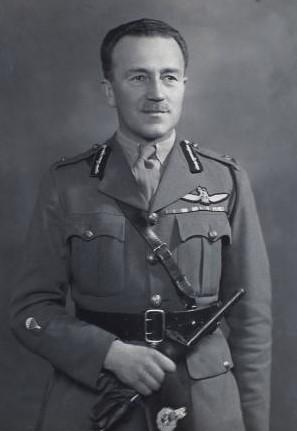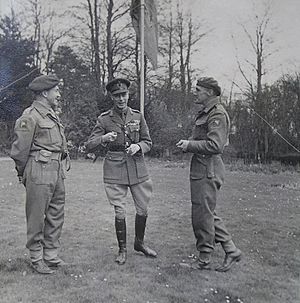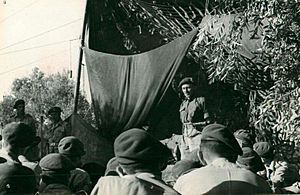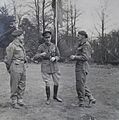George Hopkinson facts for kids
Quick facts for kids
George Hopkinson
|
|
|---|---|
 |
|
| Nickname(s) | "Hoppy" |
| Born | 14 December 1895 Retford, Nottinghamshire, England |
| Died | 9 September 1943 (aged 47) Castellaneta, Italy |
| Allegiance | United Kingdom |
| Service/ |
British Army |
| Years of service | 1915–1919 1923–1937 1939–1943 |
| Rank | Major General |
| Service number | 19368 |
| Unit | North Staffordshire Regiment |
| Commands held | 1st Airborne Division (1943) 1st Airlanding Brigade (1941–43) 31st Independent Infantry Brigade Group (1941) |
| Battles/wars | First World War Second World War |
| Awards | Officer of the Order of the British Empire Military Cross |
George Frederick Hopkinson (born December 14, 1895 – died September 9, 1943) was a brave British Army officer. He became a Major General and led the 1st Airborne Division during the Second World War. Sadly, he was killed in Italy in September 1943. He was one of the few British generals to die in battle during the war. He was also the only British general from the airborne forces to be killed.
Contents
Early Life and First World War Service
Before the First World War began, George Hopkinson worked as an apprentice. He learned engineering skills in his hometown of Retford, Nottinghamshire, England. He was too young to join the army when the war started. But in early 1915, he joined the British Army.
He became a second lieutenant in the 4th Battalion, North Staffordshire Regiment. This happened on March 27, 1915. After a short time on Guernsey, Hopkinson went to France. There, he worked as a signal officer in the 72nd Brigade. This brigade was part of the 36th (Ulster) Division.
On September 16, 1918, he received the Military Cross award. This was for his brave actions during a British Army retreat that year. The award praised his courage and calm under heavy fire. He kept communications working between headquarters and the front lines. On one occasion, he helped a wounded soldier get to safety. He did this while under heavy enemy fire. The war ended soon after with the Armistice of 11 November 1918.
Between the Wars: A Civilian and Soldier
After the First World War, Hopkinson left the army. In 1919, he went to Caius College, Cambridge. He studied to become a civil engineer. After finishing his studies, he traveled around Europe. He visited countries like Poland, the Baltic States, and Russia.
In 1923, he returned to the army as a lieutenant. He rejoined the North Staffordshire Regiment. By the next year, he became a captain. He later became an adjutant for the regiment's second battalion. He then studied to enter the Staff College, Camberley. This college was important for army officers who wanted to advance their careers.
In January 1930, he got a place at the Staff College. After graduating, he worked at the War Office in London. He was promoted to a General Staff Officer Grade III. Later, he became a GSO II at the School of Artillery at Larkhill. During this time, he also learned to fly. He earned his pilot's license in 1933. In 1936, he returned to his regiment. He commanded a rifle company as a major. However, he retired from the army again in February 1937. He took a job with a civil engineering firm in Turkey.
Second World War Service
When the Second World War started in September 1939, Hopkinson rejoined the army right away. He worked on the staff of the Supreme War Council. In November, he took command of a special Reconnaissance Unit. This unit served during the Battle of France. He was injured in a motorcycle accident. But he recovered in time to help evacuate himself and many vehicles from Dunkirk.
On August 20, 1940, he received the Officer of the Order of the British Empire (OBE). This was for his work during the Battle of France. He was especially praised for helping connect with Belgian forces. He then became a qualified parachutist. He joined the British Army's airborne forces. While training, he helped create new airborne tactics. This included how to release gliders from the planes that towed them.
In late October 1941, Hopkinson became an acting brigadier. He took command of the 31st Independent Infantry Brigade. This brigade soon became the 1st Airlanding Brigade. It then joined the new 1st Airborne Division. This division was led by Major General "Boy" Browning.
Hopkinson's brigade had mainly Regular Army units from India. They had been trained for mountain warfare. But now they had to learn a completely new way of fighting. So, most of 1942 was spent training to land in battle by glider. Hopkinson loved this new challenge. He "lived and breathed gliderborne warfare."
On April 6, 1943, Hopkinson was promoted to acting major general. He took over command of the 1st Airborne Division from Browning. Around this time, the division began to move to Algeria. Hopkinson learned that Operation Husky, the Allied invasion of Sicily, would happen in three months. He was determined that the 1st Airborne Division would take part. So, he started a tough training program. This was to make sure the division was ready.
Sicily and Italy Campaigns
Operation Husky began on the night of July 9. It started with an airborne attack. Hopkinson's old 1st Airlanding Brigade took part. It was now led by Brigadier Pip Hicks. The 1st Parachute Brigade and parts of the U.S. 82nd Airborne Division also joined. Both divisions suffered heavy losses.
Many gliders carrying the 1st Airlanding Brigade did not reach their landing zones. This was due to poor navigation and inexperienced pilots. One glider carried Hopkinson and his staff. Its tow-rope detached too early. The glider was forced to land in the sea. Hopkinson was not hurt. But he had to wait by the partly sunken glider until daylight. A Royal Navy destroyer then rescued him.
Both brigades completed their missions despite heavy casualties. They then returned to North Africa to recover. Allied ground forces continued fighting through Sicily. The fighting there ended on August 17. In early September, the Allies launched their invasion of Italy.
On September 8, the 2nd and 4th Parachute Brigades landed in Italy. Several days later, the rest of the division landed at the port of Taranto. This was part of Operation Slapstick. Hopkinson landed with the division. He accepted the surrender of the Italian forces there. He then ordered his division to advance north.
The fighting was fierce against German Fallschirmjäger (paratrooper) units. They set up ambushes and roadblocks. One roadblock was near the town of Castellaneta. On September 9, the 10th Parachute Battalion attacked this roadblock. Hopkinson was close by during the fighting. Sadly, he was killed by machine gun fire. Brigadier Ernest Down took his place. George "Hoppy" Hopkinson was the only British airborne general killed during the Second World War. He is buried in Bari War Cemetery.
Images for kids





